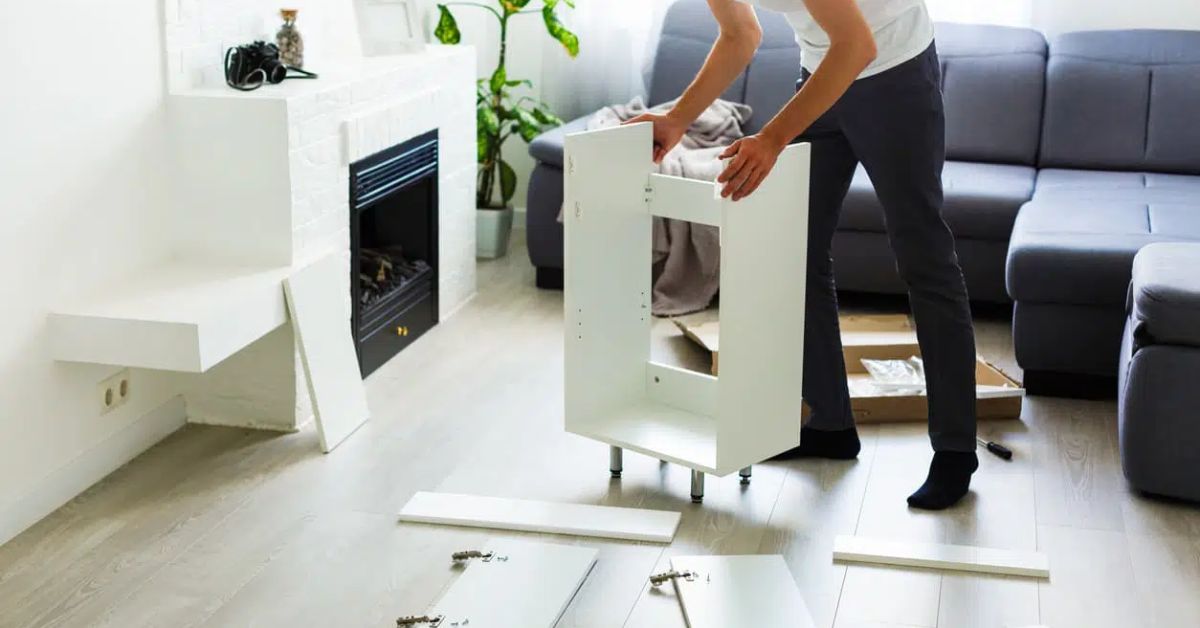Are you moving to a new place or simply need to rearrange your living space? Disassembling furniture can be a difficult task, but with the right knowledge and approach, you can tackle it like a pro.
In this expert guide, we’ll walk you through the step-by-step process of How to Disassemble Furniture with ease.
| Tool | Description |
| Screwdriver | Essential for removing screws; choose the appropriate type (Phillips or flat-head). |
| Allen Wrench | Also known as a hex key, used for hexagonal socket screws often found in furniture. |
| Adjustable Wrench | Useful for loosening nuts and bolts of various sizes. |
| Hammer | Helps with stubborn joints by providing controlled force; use a rubber mallet for wood. |
| Pliers | Handy for removing nails, staples, or gripping small components. |
| Rubber Mallet | Prevents damage to delicate parts while providing necessary force. |
Gather Your Tools
Before you begin, it’s essential to gather the necessary tools for the job. Here’s what you’ll typically need:
- Screwdriver (Phillips or flat-head depending on the screws used)
- Allen wrench (also known as a hex key)
- Adjustable wrench
- Hammer (for stubborn joints)
- Pliers (for removing stubborn nails or staples)
- Rubber mallet (to avoid damaging delicate parts)
“Experience effortless furniture relocation with our expert Furniture moving services.”
How to disassemble furniture when moving?

Disassembling furniture before a move can make the process smoother and more manageable.
Here’s a step-by-step guide on how to disassemble furniture when moving:
- Assess the Furniture: Take a close look at the furniture piece you’re about to disassemble. Identify the different components and any visible screws, bolts, or connectors.
- Prepare the Workspace: Clear out a space where you can work comfortably and lay down a soft surface like a blanket or rug to protect the furniture pieces.
- Remove Cushions and Accessories: If your furniture has cushions, pillows, or other accessories, remove them first and set them aside.
- Start with the Obvious Parts: Begin by removing any visible screws or bolts using the appropriate tool. Keep track of the hardware by placing it in a small container or bag.
- Follow the Manufacturer’s Instructions: If you still have the assembly manual, refer to it for guidance on disassembly. It may provide specific instructions or tips for easier disassembly.
- Work in Reverse Order: If you don’t have the manual, work in reverse order of assembly. Start with the last components added during assembly and work your way backward.
- Use Gentle Force: Sometimes, furniture parts may be stuck due to wear or friction. Use gentle force or a rubber mallet to loosen stubborn joints, being careful not to damage the wood or other materials.
- Label and Organize Parts: As you disassemble the furniture, label each part or component if necessary. This will make reassembly much easier later on.
- Store Carefully: Once disassembled, store the furniture parts in a safe and dry place, preferably in labeled containers or bags. This will prevent any damage or loss of components.
| Aspect | Disassemble | Dismantle |
| Definition | A methodical and organized approach to separating parts without causing damage. | To break down a structure or object into its constituent parts, often without the intention of reassembly. |
| Method | Methodical and organized approach to separating parts without causing damage. | May involve more forceful or destructive methods. |
| Reassembly | Typically implies the intention of reassembling the object. | May not result in the ability to reassemble the object in its original form. |
| Example | Disassembling furniture for moving or storage. | Dismantling a building or machinery for renovation or salvage. |
In The End!
Disassembling furniture doesn’t have to be a stressful experience. With the right tools, approach, and a bit of patience, you can dismantle your furniture like a pro.
Remember to take your time, stay organized, and handle the components with care. Before you know it, you’ll have your furniture ready for transport, storage, or reassembly in its new location.
FAQS:
Is it better to disassemble furniture when moving?
Disassembling furniture before a move can be advantageous for several reasons. It can make the furniture lighter and more manageable to carry, allowing for easier navigation through doorways, hallways, and stairs. Disassembly also reduces the risk of damage during transport by making the furniture more compact and less prone to bumps or scratches.
Can you disassemble and reassemble furniture?
Yes, most furniture pieces can be disassembled and reassembled without compromising their structural integrity. However, it’s essential to follow the manufacturer’s instructions or guidelines for disassembly and reassembly to ensure proper assembly and avoid damaging the furniture.
What tools do you need to take apart furniture?
The tools needed to disassemble furniture may vary depending on the type and complexity of the furniture piece. However, some commonly used tools for furniture disassembly include:
Screwdriver (Phillips or flat-head)
Allen wrench (hex key)
Adjustable wrench
Hammer (or rubber mallet)
What is the difference between disassembly and dismantling?
While both terms involve taking something apart, there is a subtle difference between disassemble and dismantle:
Disassembly typically refers to the process of taking apart individual components or pieces of an object, often to reassemble them later. It implies a methodical and organized approach to separating parts without causing damage.
Dismantle, on the other hand, generally suggests a more extensive or irreversible process of breaking down a structure or object into its constituent parts. Dismantling may involve more forceful or destructive methods and may not always result in the ability to reassemble the object in its original form.

